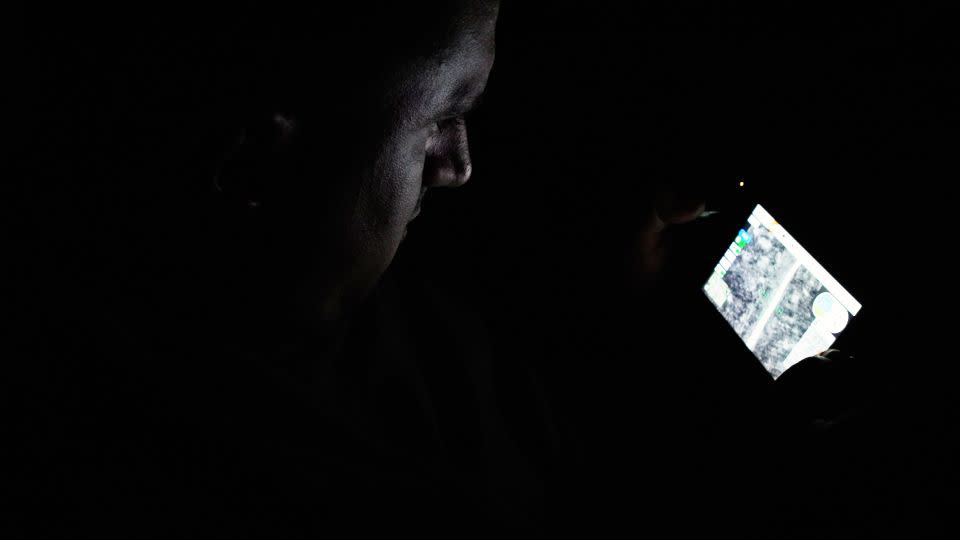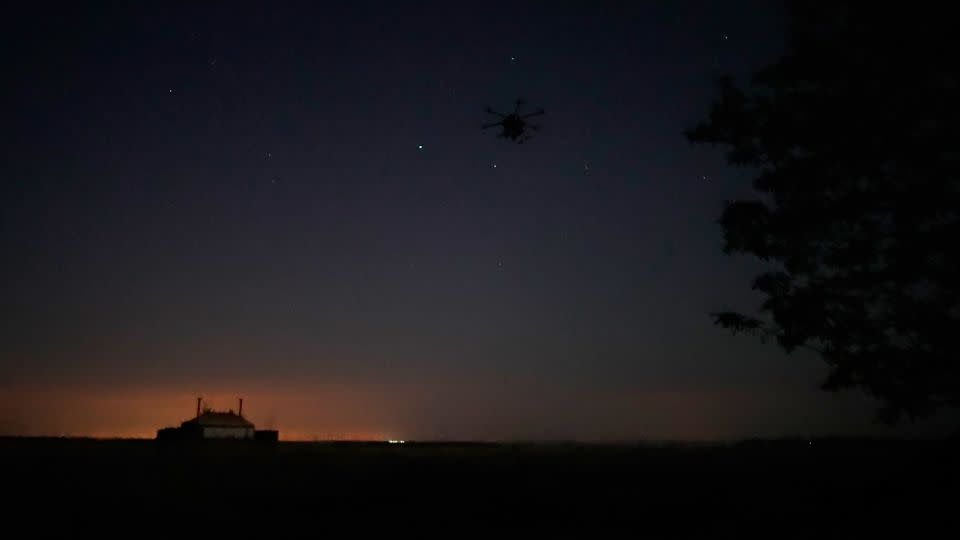‘Code 9.2’: The secretive Ukrainian drone unit tasked with dropping mines into Russia
Dusk brings an urgent race to hide before dark.
The “Code 9.2” drone unit, from the 92nd assault brigade, are moving into a new launch position from where they are about to conduct a rare and potent mission: flying drones into Russia and dropping mines onto key roads inside enemy territory.
Twilight provides a moment of opportunity to set up new equipment and unload their Humvee before dark makes these complex tasks impossible. They can only hope the grey, fading light shields them from the endless stream of Russian drones that fly overhead, looking for something to strike.
A Starlink dish, a longer range drone antenna, dozens of battery packs, and two huge “Vampire” quadcopters are dumped into trenches and bunkers, set up, and in use within 30 minutes. It is only when the dark has set in that their work can begin.
And immediately the threat is apparent. Before operators Andrey and Artem can leave the bunker to begin work, a noise sends them rushing back in for cover.
“Sssshhh,” Andrey hisses. “Orlan.” The only way to protect yourself from being seen by an Orlan – a spotter drone that can also have thermal cameras enabling it to see in the dark – is to hide. And to silently listen for it to pass. “They will be flying all night,” he says.
The horizon is peppered with flashes – distant explosions. Across its center twinkles the Russian city of Belgorod, now repeatedly hit by Ukrainian strikes. Russian President Vladimir Putin has claimed his week-old offensive into Kharkiv region in Ukraine is partially aimed at creating a buffer zone along the border to protect a population whose safety was never in doubt when he launched his invasion in February 2022.
The bunker is quickly turned into an operations hub, the team finding it hard to adjust to the silent open fields of their new home, after months of fierce battles around Bakhmut.

In the silence, Artem says, “you don’t know, will you get hit or not.” He points out the difference with Ukraine’s failed defense last year of Bakhmut, in the eastern Donetsk region – and their work tonight, about four miles from the border. Here the heavy foliage, lack of fixed front lines and proximity to Russia means “reconnaissance groups enter and can get anywhere.” They joke they could wake up to a Russian soldier standing over them.
For Artem though this fight is intensely personal. His parents still live in a partially destroyed village a short drive away. For 18 months he deceived them by saying he was stationed at a peaceful checkpoint, when he was really fighting on the front lines. Now they know he is nearby, and the feeling of fighting for his actual home leaves him feeling unsettled.
“Anxiety,” he says of the main feeling. “My parents are right here so if, God forbid, we fail somehow, if there is a breakthrough… it’s a big responsibility.”
Dark has set in, punctured only by the flashes of artillery strikes and the near-full moon. The team move to work fast. Artem and Andrey race to attach the mines to the drone, using only red lights. Suddenly, a tiny whining noise is audible.
“Run,” says Andrey, and they take cover in a nearby bunker. Spotted once, the trenches could become a target for airstrikes and artillery all night, and there is little chance to escape: they have no vehicle and racing across open ground on foot is perilous too.
A few minutes pass. Flares illuminate an adjacent field. Battles are raging elsewhere too. The team resumes work. Zip ties prime fuses. Masking tape readies explosive. Then again, another drone passes close by, and they race again for shelter.

Interrupted twice, and a little breathless from racing for cover, the team are finally ready to launch.
Back in the bunker, the pilot Sasha can see fields flow below the Vampire on its night vision camera. He points out the border line, and then adds: “Now, we are already in Russia”.
“Did you bring your passport?” quips Artem. “I can go without a visa,” replies Sasha.
Being funny used to be the third team member’s job, before the war dragged Ukrainians of disparate professions into trenches. Andrey was a comic, and briefly worked with Volodymyr Zelensky – long before his days as a politician and Ukrainian president when he was a TV producer and actor – on his comedy show. “Honestly, he had one of the best vibes among the people I met,” he says.
“The strongest energy. It is always interesting with him. We spent a lot of time together, one on one.”
It is a peculiar trait of the Ukrainian force, compared to their enemy: it is unlikely any of Putin’s troops spent time on stage with the Kremlin head cracking jokes before the war.
The drone flies deeper into Russia, and then warning messages ring out loudly in the bunker, on grating repeat, signalling that GPS jammers are at work. Sasha is briefly concerned they may lose the drone. The livestream cuts. He thumbs the controls agitatedly.
But then minutes later, the signal is restored: the drone has flown through the interference, kept on course, and can now continue towards the target. Moments later, two packages drop from its underbelly. The mines sit on the road, and later the next day, the unit says, hit one armored car and a soft skin vehicle.
As the drone approaches, the team have two problems. Firstly, its GPS system appears damaged and it crashes unceremoniously into the field, upside down. Secondly, they think they can see an Russian Orlan that appears to have followed the drone back into Ukraine, perhaps seeking their launch position. The team stay in shelter a few minutes, hoping the threat passes. Shells whistle overhead and crash into nearby fields. They retrieve the drone, but must rely on their spare until dawn, when daylight will give them a chance to assess the damage.
The sorties continue, the team saying they hold the record for the most Vampire flights in one night of 24. But their target now is Russia itself, a powerful symbol of Kyiv’s decision to take the fight back to Moscow, and the new, dangerous escalatory turns this conflict is taking in its third year.
For more CNN news and newsletters create an account at CNN.com

